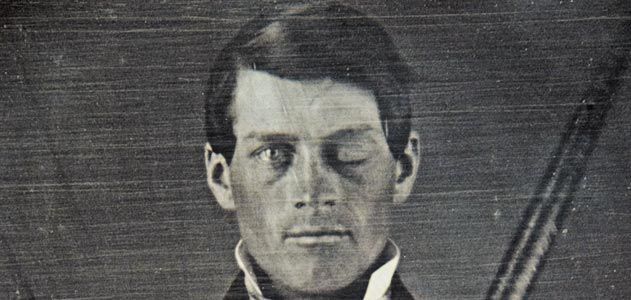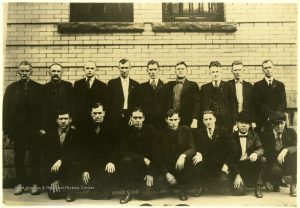It was not an extraordinary day in Cavendish, Vermont. To most people, this day was perfectly normal. September 13, 1848 was just another Wednesday. Phineas Gage, a foreman working for Rutland & Burlington Railroad, would have agreed that this day was no different from any other. Or, at least that’s how it started.1
On this day in September 1848, Gage was only 25 years old. Gage, by all means, was not extraordinary. He was very average. He stood at 5 feet 6 inches, and he was physically strong, as was needed for his job. He was kind, well-mannered, intelligent, and had a good temper. On this day, Gage was putting explosive powder into an iron. It was part of his job, and something he had done before. Gage, a cautious man, usually paid attention to what he was doing. For some reason, he turned his head for a second. He looked away. That was all it took. In one second, his life changed forever.2
The powder Gage was putting into the iron activated, causing an explosion. Surprised, he didn’t have a time to react. The force blew him from where he was standing, and he landed a couple of feet away from his original position. The iron rod went through his left cheek and then out of his skull. Days later it was found by Gage’s men, about 80 feet away from where Gage landed, smeared with blood and brain.3

Miraculously, Gage didn’t pass out from the impact or the bleeding. He got up, went to the town, went into a hotel, and waited there for a doctor. All with little help. When the local doctor arrived, Gage spoke to him and said, “Doctor, here is business enough for you.” Dr. Williams couldn’t believe him — if his story was true and an iron went through his head, how was Gage still standing and talking? How was he fully conscious? It wasn’t until an Irishman standing nearby added to their conversation, stating the rod was still on the floor over by the railroad, “all blood and bits,” that Dr. William believed him.4
Dr. Williams, realizing he wasn’t exactly qualified to treat Gage’s injury called over Dr. John Harlow. In today’s terms, calling Dr. Harlow a neurosurgeon wouldn’t be correct. At this time, neuroscience wasn’t even known, much less an actual field of study. Still, Dr. Harlow treated Gage and managed to stop the hemorrhage Gage had. Even though Phineas Gage experienced severe trauma, he didn’t seem very bothered, nor did he show any signs of stress. Gage even told the doctor that he didn’t want his friends or family to come visit him. After all, his accident wasn’t very serious, and he would return to work in a couple of days time. Through this process, Gage was conscious, and the traces left by the iron and rust were a testament to his accident.5
It took a while for Gage to recover. Not surprisingly. Dr. Harlow kept a clear record of his whole treatment. He kept an almost day-by-day journal filled with his observations, as well as the treatment Gage was receiving. He had an infection, but as Dr. Harlow treated it, it went away fairly quickly. At times during his recovery, Gage would sometimes seem delirious, but that would clear up almost immediately. It was remarkable.6 Really, no one would have guessed what was truly wrong with him until they analyzed him fully. On top of his head, there was an inverted tunnel showing where the rod had come out of. On his left cheek, there was a hole. Small pieces of Gage’s brain appeared scattered throughout his scalp, stuck to his hair. Dr. Harlow described in his report later on, that as he pressed against Gage’s skull, “The pulsations of the brain were distinctly seen and felt.”7 A month later, Gage was able to stand and walk around. Neurologically, he appeared in tact.

The news of his accident quickly spread. Soon enough, Gage was the main topic for articles in his town. This, however, was not what lead to his fame, in fact, Gage wasn’t exactly flourishing after this accident. It was the opposite.
Physically, he wasn’t much different than before. He was still physically capable, although his left eye would stay shut forever, and the left side of his face was partially paralyzed.8 Dr. Harlow would even go so far as to say he had fully recovered. Gage stated he felt fine, but he had an odd feeling. But, it was a feeling not even he could describe. He had no pain, but something was different in his head.9

Even though he was physically capable of doing most things, he couldn’t hold down a job. His old employer refused to hire him again. Something had changed, and it wasn’t in Gage’s physical performance. After the accident everyone collectively agreed, “Gage was no longer Gage.”10 Dr. Harlow detailed these changes. Reportedly, Gage’s personality and behavior drastically changed. The capable and efficient man people hired and knew was gone. He was replaced by a different type of man. Gage now used profanity, something he hadn’t done before. He showed little emotion or care for his coworkers and previous friends. He was irrational, with a short temper.11

Years after the accident, Gage continued to find himself unemployed. His ill-advised decisions caused by his new personality didn’t land him very far. Instead, Gage sought other ways to make money.12 He exhibited himself as a circus act, carrying the famous iron rod. Of course, every job he held was short lived, and he wasn’t a circus act his whole life. He also traveled traveled. He went from through New England, all the way to Chile. His jobs were mostly manual types of work, like driving a stagecoach. Throughout all his travels, he carried the rod with him, like it was a part of him, his only companion.13
In 1860, at the young age of 36, Gage began to experience seizures. He returned home to California, where he reunited with his mother and sister, his only family. Dr. Harlow would later report that after every epileptic convulsion, Gage had no memory of them. Eventually, on May 21st, 1860, after a series of continuous seizures, Phineas Gage died. It was exactly, “twelve years, six months and eight days after the date of his injury.”14

Phineas Gage’s story, as well as the later exhumation of his bones, led to the discovery and subsequent explorations of the brain. His story is one that’s commonly looked at, and it is referred to as “Neuroscience’s most famous case.”15 It led to advancements in what we now know about brain injuries, and how to treat them. Still, sometimes Phineas Gage himself is forgotten. He should be remembered not just as a case, or as an interesting phenomenon, but as a person. He was a good-looking, kind, confident, assertive, young man.16 He had a family, friends, and lived a good life. He was an ordinary man, who experienced an extraordinary injury. And, we should never forget him for that.
- John Martyn Harlow, “Recovery from the passage of an iron bar through the head,” Publications of the Massachusetts Medical Society 2, no. 3 (1868): 4. ↵
- John Martyn Harlow, “Recovery from the passage of an iron bar through the head,” Publications of the Massachusetts Medical Society 2, no. 3 (1868): 4. ↵
- TL Guidotti, “Phineas Gage and His Frontal Lobe- The “American Crowbar Case”,” Archives of Environmental & Occupational Health 67, no. 4 (2012): 249. ↵
- Malcolm Macmillan, Odd Kind of Fame: Stories of Phineas Gage (Cambridge: MIT Press, 2000), 43-44. ↵
- John Martyn Harlow, “Recovery from the passage of an iron bar through the head,” Publications of the Massachusetts Medical Society 2, no. 3 (1868): 7. ↵
- Andrew Grieve, “Phineas P Gage—‘The man with the Iron bad’,” Trauma 12, no 3 (2010): 172. ↵
- John Martyn Harlow, “Recovery from the passage of an iron bar through the head,” Publications of the Massachusetts Medical Society 2, no. 3 (1868): 5. ↵
- TL Guidotti, “Phineas Gage and His Frontal Lobe- The “American Crowbar Case”,” Archives of Environmental & Occupational Health 67, no. 4 (2012): 249-250. ↵
- John Martyn Harlow, “Recovery from the passage of an iron bar through the head,” Publications of the Massachusetts Medical Society 2, no. 3 (1868): 12. ↵
- TL Guidotti, “Phineas Gage and His Frontal Lobe- The “American Crowbar Case”,” Archives of Environmental & Occupational Health 67, no. 4 (2012): 249-250. ↵
- John Martyn Harlow, “Recovery from the passage of an iron bar through the head,” Publications of the Massachusetts Medical Society 2, no. 3 (1868): 11-12. ↵
- Encylopedia of Social Psychology, 2007, s.v. “Social Cognitive Neuroscience,” by Matthew D. Lieberman. ↵
- TL Guidotti, “Phineas Gage and His Frontal Lobe- The “American Crowbar Case”,” Archives of Environmental & Occupational Health 67, no. 4 (2012): 249-250. ↵
- John Martyn Harlow, “Recovery from the passage of an iron bar through the head,” Publications of the Massachusetts Medical Society 2, no. 3 (1868): 14. ↵
- Andrew Grieve, “Phineas P Gage—‘The man with the Iron bad’,” Trauma 12, no 3 (2010): 173. ↵
- TL Guidotti, “Phineas Gage and His Frontal Lobe- The “American Crowbar Case”,” Archives of Environmental & Occupational Health 67, no. 4 (2012): 250. ↵




50 comments
Anthony Coronado
This was a very well known story, as being heard in Anatomy. While I heard of the incident as well as the overall breakthrough study on his brain post-accident and trauma. This article was most inciteful to his behavioral and emotional change post-incident, which affected his whole life, resulting in his mental instability. It is still quite surprising to me that he did not suffer from any physical impairments except to his sight to one of his eyes, which isn’t as major to the possibility as any form of paralyzation.
Seth Roen
I can only imagine the will nearly splitting headache the man had to go through, and probably the ones for the rest of his life. Also, I bet it was off-putting, to say the least of how claim he was throughout the whole ordeal. The word “Miraculously” is probably the best way to describe the events that day, but I do think he spent most of his luck in his life that day. I’m curious how the rest of his life went after that day.
Carlos Apodaca
This article really puts into perspective how far science has come in the health industry, like the article states, there were no qualified doctors that give Gage the proper medical help. Its crazy that after such insane injuries he was still able to continue to live a life, although he was suffering with changes in his personality and seizures its still an insane medical story. Its very interesting to read about his life and how he changed after the injury occured and it must have been a breakthrough case at that time.
Caily Torres
This was a very fascinating article. I find it interesting that after going through a traumatic event like he did, that he was still conscious and acting like nothing had happened. Was it adrenaline? I also find it interesting that after the accident, he recovered fairly quickly, however, his personality drastically changed. Going through something as traumatic as he did, I can understand him not being the same as before, but he was a different person, he was the opposite of everything he used to be. After reading this article, I wish I would’ve read about Phineas Gage before.
Melissa Garza
Isn’t this story just crazy?! I learned about the case of Phineas Gage in my high school Sociology class. It is absolutely incredible how the brain works. Especially having an injury impact your personality that you spent your whole life building. Because we really do spend our whole life to build our personality based off our experiences. So it is quite confusing that his personality was changed just because of his injury. Also the injury its self is crazy to think about! A whole rod went through his head??
Mark Dominguez
A very fascinating and well written article, prior to reading this, I had heard about Phineas Gage’s story but there was a lot of details that I did not know. Although I can’t tell if he had good or bad luck since it’s a miracle that he was able to survive such a horrific accident but his personality completely changed as a result. It’s interesting to see how much of a contribution this case had to science.
Amanda Quiroz
Great article! I have studied Phineas Gage back in a class I took my junior year of high school. It’s a miracle that he survived but the end result was tragic. I can’t imagine living but not being myself. It’s sad that it ended like that. He had become an entirely different person after he was impaled by the rod.
Jose Chaman
Very good article. I had already studied Phineas Gage’s case at high school before, however, this article has done an excellent job describing Gage’s life and how it ended up being traversed by that metal bar. It is impressive how for the time they were able to remove the metal and make the correct medical treatment to Gage. It is also interesting to see the radical personality change that he and his family members faced.
Alin Bocardo Felix
The human brain is an extraordinary concept, how is it that he was physically okay but he changed? Therefore it dwells deeper into what we assume what a person, or even a soul, truly is. I once read another article on a young man that attempted suicide with a shot through the head, from within the mouth, because he was tired of being bullied for his stutter. Oddly enough, he survived and the only part that the bullet affected was that of the stutter, which completely removed it. It’s a great read and very well written.
Emmanuel Diaz
One word, “WOW!” For the very little knowledge that there was in medicine this must have been absolutely breath taking and quite frankly very disturbing but in an interesting way! It’s compelling as to how Phineas even withstood the impact of the rod without collapsing or even at that simply dying! Even a small hit to the head could cause catastrophic damage and there he was walking and talking while being impaled by the rod. Sadly he did face a lot fo struggles after this but what was one to do or say, this had never happened! It was truly unique